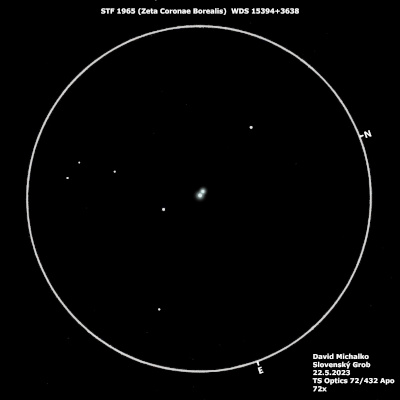Crb
☀4.96/5.91mag
Ø
6''

STF 1965 (Zeta Coronae Borealis) appears at first glance as a beautiful, bright, easily distinguishable binary star system. In reality, however, it is a quintuple system located 473 light-years away from the Sun. The primary component (A, Zeta 2) is a spectroscopic triple star system composed of two blue-white main-sequence stars with spectral classes B7V and an additional star with an as-yet-unknown spectral class. The stars are 4.13, 3.73, and 3.78 times more massive than our Sun. Two closer stars orbit around their center of mass with a period of 1.72 days. A third star revolves around this pair with a period of 251 days. The companion (B, Zeta 1) is a spectroscopic binary with a spectral class of B9V, and its components orbit around their center of mass with a period of 9.5 days. Therefore, Zeta Coronae Borealis is a quintuple system, comprising 3+2 stars.
72mm - STF 1965 is located approximately 10° north of the brightest star in the Corona Borealis constellation - Gemma. The components are easily distinguishable even at moderate magnification. At 72x, both components appeared white to me, although occasionally, I thought there might be a hint of a bluish tinge.